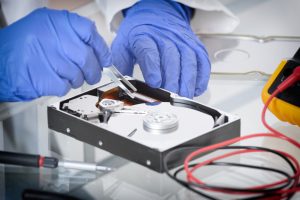IT Asset Lifecycle Management
Introduction
What is asset lifecycle management? In essence, it’s the discipline covering all considerations relevant to an organization’s deployment of technology, from pre-planning to the retirement of the infrastructure — that is, the IT asset lifecycle.
The hardware asset management lifecycle takes in elements relating to equipment purchase, operation, maintenance, and ultimate disposition.
Asset lifecycle management enables organizations to keep track of all these elements and consider the software powering IT systems, licensing considerations, and other factors.
In this article, we’ll be taking a closer look at these activities.
What is the Asset Life Cycle?
IT asset disposition or ITAD is the set of commercial operations and processes that focus on the final stages of the IT asset lifecycle — getting rid of obsolete or unwanted equipment in a safe and ecologically responsible manner.
We can define an asset as any item or entity that has the potential to give actual value to an organization. Asset management is the set of coordinated activities that the organization can engage in to realize value from its assets. In this regard, the principal objective of asset management is to maximize the returns from various assets while minimizing the costs that they incur while serving a valuable function for the organization.
An asset lifecycle is a series of stages involved in the management of an asset. It starts with the planning stages when the need for an asset is identified and continues through its useful life and eventual disposal.

Commercial organizations and other institutions now routinely rely on their digital infrastructure to run their operations and deliver their services. This infrastructure consists of various IT assets, including networking equipment, servers, and computers. However, ancillary infrastructure elements such as cables, storage racks, and work desks also come into the picture.
So what is asset lifecycle management in the IT context?
All items within an Information Technology or IT environment cost money to obtain and install, and most, if not all, will require some degree of maintenance during their service life. During their life of service, much of the hardware and software will be processing and storing digital assets in the form of data, a fair proportion of which may be sensitive or valuable information such as intellectual property, personal and financial credentials, transaction records, passwords, and various kinds of digital media.
To safeguard all of this information and ensure the equipment’s continuing viability that stores and processes it, continuous monitoring, maintenance, and auditing are required.

Make an Informed Decision
What is Asset Lifecycle Management?
ITAD or IT Asset disposition is also a business model in which vendors and service providers specialize in streamlining the disposal of IT assets while minimizing costs and maximizing the returns that their clients can gain on the process by refurbishing, reselling, or recycling the old material. This enables clients to reduce their losses due to depreciation and regain value from the disposal of IT assets.
The lifecycle of an asset consists of several stages. Generally, the fixed asset lifecycle of a commodity begins when an organization first acquires the asset and ends when the organization disposes of that same asset. Along the way, some depreciation in its value may occur as the asset undergoes repairs, upgrades, or maintenance during service. Its value may also fluctuate during its service life, as the asset contributes to a lesser or greater extent to the organization’s financial fortunes, its implementation of operations or service delivery, and other factors.
The asset lifecycle management principle applies to fixed or solid assets such as real estate, capital funds, physical infrastructure, and human resources. It also applies to less tangible assets such as expertise, innovation, brand image, and brand reputation.
IT Asset Lifecycle Management or ITALM is a core function of the more general field of IT Asset Management or ITAM. The principal aim of ITALM is to assist organizations in boosting their productivity through the making of informed decisions on IT needs and services, based on careful monitoring of the organization’s various IT various resources and their lifecycle stages.

Why Asset Lifecycle Management is Important
As an IT asset progresses through its lifecycle, the valuable contribution to the organization will alter, and so will its status, as changes occur to the financial, contractual, and physical data associated with the asset.
According to the leading business analytics firm Gartner Inc., asset lifecycle management practices are required for improving the return on investment for IT assets, avoiding internal and external audit consequences, and adopting future technology.
For example, in terms of future technology adoption, if a particular IT asset is about to expire or be retired and your IT asset lifecycle management software lets you know that the aging asset is in your inventory, you’ll have greater lead time to order new equipment to replace it.

See how much your IT equipment is worth
Stages in Asset Lifecycle Management
Most analysts agree that IT asset lifecycle management processes occur in five principal stages.
Procurement or Acquisition
This first stage of the asset lifecycle process involves the market research and budgeting that precede the actual purchase of an IT asset. A needs analysis for the organization typically accompanies the purchase planning phase, with data also being used to forecast the anticipated benefits that justify the final purchase.
A workflow for this stage of the lifecycle would look like this:
- Conduct a needs and projected benefits analysis.
- Do market research.
- Link to organizational cost budgets.
- Create Purchase Order (PO).
- Get Purchase Order approval.
- Add purchase to the inventory.

Deployment
This stage of the IT asset lifecycle includes all the preparatory work and space planning that must take place before the newly acquired asset is put into use. If the assembly of the asset is required, this is done at this stage, and preliminary checks are performed for any physical defects, design faults, or engineering problems. Safety and security checks before installation and fixing any relevant monitoring devices or tags may also occur at this time.
The deployment workflow might be of this form:
- Prepare installation site.
- Assemble the asset.
- Deploy the asset.
- Transfer its classification from “Inventory” to “In Use.”
- Categorize the asset under the relevant software or hardware inventory.
- Issue relevant software to the hardware asset.
Utilization
This is potentially the longest stage in the hardware asset management lifecycle. During service, the performance of each asset is continuously monitored for any issues that might arise to detract from getting the maximum value from using the item. Any necessary upgrades, patches, license renewal, and auditing for compliance will occur during this period. Cost-benefit analysis may also be run to establish the revenue and returns earned on the capital investment for the asset.
Maintenance
As the asset ages, maintenance operations will typically be required to help extend its productive life. Modifications and upgrades may be applied to hardware, and updates to software installations and licensing may be necessary for this phase.
Disposition or Disposal
As equipment and infrastructure become obsolete or increasingly defective, these items reach the end of their IT asset lifecycle. The decision must then be made to retire or dispose of them. Safe and secure disposition typically requires the organization to remove data from the hard drive and other storage media and implement conditions for secure asset disposal. This might be through the resale or onward donation of securely sanitized equipment, recycling, or environmentally sanctioned destruction and disposal.
Asset Lifecycle Best Practices
In following asset lifecycle management best practices at the level of your organization, there are three key aspects to implement when creating an IT asset lifecycle management process:
1. Management Strategy
Take a strategic approach to foster a shared vision of IT asset lifecycle management throughout the enterprise. This should involve communicating the business benefits of your management strategy to all relevant stakeholders, including IT personnel and senior executives. The objective of this strategy should be to create a consensus view on business objectives and program implementation by exploring the IT assets that your organization currently possesses, their relative importance, and what their future costs and values might be.
2. IT Asset Lifecycle Management Implementation
Planning and implementing your IT asset management lifecycle program should throw a clear light on how assets are being used and the value they contribute throughout their lifespan. The strategic plan should also include stipulations for the disposition of high-cost or obsolete assets.
3. Defining Roles and Responsibilities Within the Organization
The role and responsibility of each stakeholder in the lifecycle management process should be clearly defined and communicated. You should also ensure that all necessary and relevant resources for management implementation have been budgeted for and are in place.
Creating an Asset Lifecycle Management Plan
With this organizational approach in place, you can follow a straightforward and systematic procedure to create your IT asset lifecycle management plan:
- Gather information about the IT assets available to your organization.
- Determine which assets are yielding the most value, so you can concentrate your asset lifecycle management and monitoring efforts on them in terms of their priority.
- Create a software or hardware asset management lifecycle strategy for each asset.

Benefits of Lifecycle Management
In a recent assessment by the business analysis firm Deloitte, it was discovered that if organizations manage their software assets properly, they can save on average 25% of their annual maintenance costs.
For the organization, IT asset lifecycle management bestows a number of benefits, including:
- Information and insights to better forecast your IT infrastructure needs.
- Guidance for making informed purchase order decisions.
- The knowledge to become more proactive when it comes to replenishing resources.
- Management capabilities to improve the quality of IT services in your organization.
- Awareness of the Total Cost of Ownership (TCO) of each asset.
The Importance of Long-Term Planning
IT asset lifecycle management shouldn’t be undertaken from a short-term perspective. Planning for the long term will give a greater understanding of the current condition and capacity of your company’s IT infrastructure, as well as helping to identify future functional, capacity, and reliability requirements.
This will enable you to make more informed predictions about where and when infrastructure investments should occur. Taking a longer-term view will also give you greater scope to assess the costs and risks associated with implementing system improvements or expansions right away or putting them off till a later time.

A Word on IT Asset Disposition
Retirement or disposal is the inevitable final stage of the IT asset lifecycle. And while monitoring the performance, condition, and value contribution of IT infrastructure in service is critical to the organization, ensuring that end-of-life assets are properly disposed of can be just as important.
In industries like healthcare and financial services, strict laws and regulatory compliance rules govern the way in which IT equipment and data storage media must be sanitized, recycled, and disposed. Failure to comply with these regulations can attract stiff financial penalties or legal action.
To ensure that you remain compliant with all the relevant statutes and dispose of hard drives securely, you should engage the services of a reputable ITAD service — one that’s certified to all the relevant industry standards and is fully prepared to supply all the necessary Chain of Custody documentation and Certificate of Destruction verification to meet your own audit requirements.
A leader in the ITAD industry, TechReset goes beyond recycling computers. We fully repurpose units to extend the life of IT equipment beyond its first use. TechReset offers on-site device removal, certified audit reporting, and completely secure data eradication through gold standard data cleanse software or physical hard drive shredding.
Related Posts

The Significance Of Data Safety In The Process Of Recycling
Data safety can’t be ignored, here’s why… Are there any IT assets that don’t store, access, process or backup data in today’s digital world? Irrespective

Proper Storing & Staging Of IT Assets For Disposal
IT assets can quickly become a serious liability if they aren’t properly processed at end-of-life. Data breaches in Canada and the United States are mounting

What are the Differences between ITAD and Recycling?
In today’s digital climate, Information Technology Asset Disposition (ITAD) companies are an extremely useful resource when it comes to handling the safe and reliable disposal
